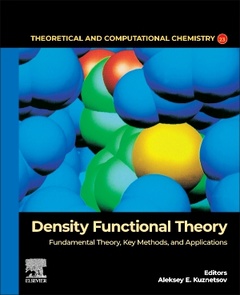Density Functional Theory Fundamental Theory, Key Methods, and Applications Theoretical and Computational Chemistry Series
Coordonnateur : E Kuznetsov Aleksey

Density Functional Theory: Fundamental Theory, Key Methods, and Applications provides a thorough and detailed explanation and overview of this important computational quantum mechanical modeling method and its applications. The book's chapters are structured to be easier to understand and more accessible to the target audience. Split into three distinct sections, it examines foundational knowledge surrounding DFT, covering key concepts such as the Thomas-Fermi model and Hohenberg-Kohn-Sham theory, exchange-correlation functionals, the advantages and disadvantages of DFT compared to MO theory, and other methods before exploring areas of future DFT development. The second section then examines practical methods and approaches for DFT, looking at the types of density functionals such as LSDA, GGA and meta-GGA functionals, hybrid functionals, DFTB methods, dispersion corrected functionals, Time-Dependent DFT, and the Plane-wave approach. It also looks at relations between DFT and ab initio molecular dynamics and the QM/MM approach. The final section then focuses on applications and some useful case studies of use of DFT in different areas, whilst weighing up strengths and weaknesses in such applications.
Part I: Foundational Knowledge 1. History of the DFT concept: inspiring ideas and development 2.DFT concept: Thomas-Fermi model and Hohenberg-Kohn-Sham theory, their comparisons and applicability 3. Exchange-correlation functionals: review, history, areas of applications 4. Novel and recently designed DFT functionals, their advantages and applications 5. Advantages and disadvantages of DFT compared to MO theory and other methods: scalability, ways to improve, areas of applications 6. Density matrix functional theory 7. Machine-learning of DFT functionals 8. Linear scaling of DFT methods 9. Future DFT development: theory, conceptual applications, computational improvement Part II: Methods and Approaches 10. Local-spin density approximation: history, present state, applications 11. GGA, meta-GGA, and hybrid functionals: development, applications, perspectives 12. Semiempirical DFT: DFTB, parametrization, present state, and perspectives 13. Dispersion corrected functionals: development, future perspectives, applications 14. Time-Dependent DFT: development, future perspectives, applications 15. Plane-wave approach 16. Relations between DFT and ab initio molecular dynamics 17. Relations between DFT and QM/MM approach 19. DFT methods use and peculiarities for vibrational (phonons) calculations 20. DFT methods use and peculiarities for transition state search 21. DFT methods use and peculiarities for various spectral properties investigations 22. DFT methods use and peculiarities for study of different spin-states 23. DFT methods use and peculiarities for chemical reactions studies 24. DFT methods use and peculiarities for solid-state studies Part III: Applications and Case Studies 25. Areas of good and poor performance of DFT: various multiplicities, weak interactions, loosely bound electrons, structures, chemical bonding 26. DFT in studies of complexes/systems with hydrogen bonding: history, present state, and perspectives, functionals used, ways to improve the performance 27. DFT in studies of complexes/systems with dispersion interactions: history, present state, and perspectives – complexes of graphene etc., functionals used, ways to improve the performance 28. DFT for reactivity studies/conceptual DFT: history, current state, and perspectives 29. DFT in design of pharmacologically active compounds: organic compounds, organometallic compounds, approaches used, perspectives and improvement routes 30. DFT applications in transition metal studies: history, present state, perspectives, functionals employed, issues and the ways to overcome them 31. DFT for design of compounds for alternative/sustainable energetics: history, present state, approach used and perspectives 32. DFT in design of anticorrosive compounds: current state, perspectives, approaches 33. DFT in engineering of crystals and related systems 34. DFT in design of semiconductors and oxides 35. DFT in catalysis studies: history, current situation, future, approaches used, problems and ways to overcome them 36. DFT in design of solid-state catalysts 37. DFT in studies of biologically relevant systems: history, present state, restrictions and problems encountered, future perspectives 38. DFT methods for large systems
- Provides a comprehensive and broad, yet detailed overview of theory, methods and practical applications of Density Functional Theory (DFT) geared chiefly towards theoretical (computational) and physical chemistry
- Meets the need for an up-to-date work focused more heavily on chemistry applications of DFT than most existing literature
- Designed to be more accessible to late undergraduate, graduate, and postdoc researchers getting to grips with DFT, where existing literature has mostly been quite impenetrable and very specific
- Incorporates case studies of practical applications of DFT and objectively weighs up the advantages and disadvantages and recent and future potential advances
Date de parution : 10-2024
Ouvrage de 576 p.
15x22.8 cm
Thème de Density Functional Theory :
Mots-clés :
<; p>; Exchange-correlation functionals; Local spin-density approximation; generalized gradient approximation; pure functionals; dispersion correction; hybrid functionals; interaction energies; binding energies; Hartree-Fock approximation; ab initio molecular dynamics; QM/MM approach; catalytic; corrosion; non-covalent bonding; pharmacological design; crystal design; transition state search; structures optimization; reactivity; spectroscopy<; /p>



